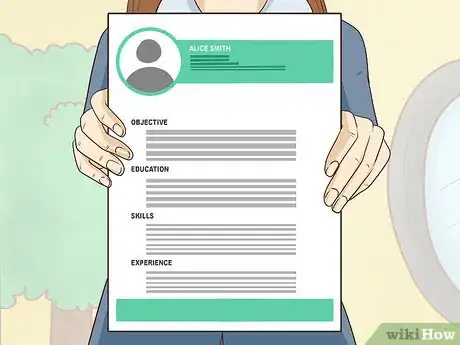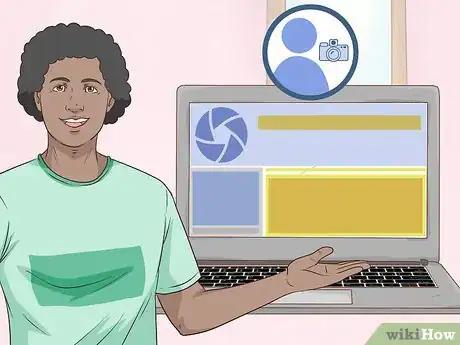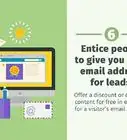This article was co-authored by Joui Turandot and by wikiHow staff writer, Danielle Blinka, MA, MPA. Joui Turandot is a Personal and Creative Branding Consultant and the Founder of JTM Consulting, a business that specializes in public persona branding, business branding, creative leadership coaching, and speaking workshops. Joui has more than 10 years of experience as a fashion designer, filmmaker, photographer, costume designer, stylist, and personal development coach. She uses her diverse experience to guide creative leaders and entrepreneurs through a journey of self-discovery and embodied personal expression to help them grow their business and step into the next level of leadership. Joui holds a BA in Media Studies from Mills College and holds credentials in the Somatica Core Training Method by the Somatica Institute and in the Art of Circling Training by The Circling Institute.
There are 8 references cited in this article, which can be found at the bottom of the page.
This article has been viewed 172,549 times.
You’ve likely heard that you need to be able to market yourself in today’s job market, but actually doing it can feel overwhelming. Whether you’re creating your own job or applying for one, knowing how to market yourself will help you be successful. Before you can start marketing yourself, you need to create your personal brand. Then, you can reach out to your audience to promote yourself as an entrepreneur or to apply for a job.
Steps
Getting a Job
-
1Present yourself as a professional in your area of expertise. Dress to fit the role you're trying to take, such as business casual. Additionally, make sure your hairstyle and grooming habits also fit the standard for your field. When you meet with a potential employer or client, don't wear too much fragrance because it may trigger allergies and is considered disrespectful.[1]
- Professional attire can vary depending on what type of work you do. For instance, a consultant might wear a suit or sheath dress, while a freelance tattoo artist might prefer an outfit that shows off their tattoos and creativity.
- Similarly, appropriate hairstyles can vary. For instance, you might be more likely to get a job with a Fortune 500 company if you have a conservative hairstyle. On the other hand, a hair stylist or muralist may attract more attention with a bold cut or hair color.
-
2Use a firm handshake and eye contact to convey confidence. Body language tells people a lot about how you're feeling, and you can use this to your advantage. When you're meeting with a client or potential employer, make eye contact as you approach them. Then, give a firm handshake. While you're talking, continue to make eye contact.[2]
- This will make the person perceive you as confident and self-assured, even if you're actually nervous.
- To get better at making eye contact, ask a friend to make sustained eye contact with you for 5-10 minutes. Repeat this exercise until you feel more comfortable staring into someone's eyes.
Advertisement -
3Answer questions as though you're sure of yourself. It's normal to feel nervous when you're trying to sell yourself, and that can come through when you're answering questions. Be definitive about the answers you give. Keep your voice firm and assertive so that the person believes your responses. If you're completely stumped on a question, tell them that you'll check on it and get back to them within 24 hours.[3]
- You might say, "That's a great question. Let me double check my numbers and I'll have an answer for you within 24 hours."
-
4Create a polished resume. Present your name and contact information at the top of your resume. Then, list your educational experience. Use the bulk of your resume to describe your work experience or skills. Update your resume at least once a month so you know it’s accurate.[4]
- Include keywords on your resume so that the employer knows that you fit what they’re looking for. Whenever possible, use actual keywords from the job posting.
- Use strong verbs to describe what you accomplished at your past jobs.
Tip: If you’re not currently working, take free online classes and attend free job workshops to build your professional skills. Include these classes on your resume.
-
5Tell stories to demonstrate your strengths and skills. Talking about your skills is hard, but anecdotes might be the solution. To find an story, list the skills or strengths you want to present. Then, think about times in your career or life where you displayed those skills. Write about these experiences, then revise what you've written to create a short anecdote.[5]
- For instance, let's say you want to show that you're innovative and great at collaboration. You might say, "The first website I designed was tricky because my client had built their original website. Since he was proud of his efforts, I wanted to keep what was working. For the first phase of the design, I worked closely with him so he still felt like the site belonged to him. Then, I created a unique format that won him a professional award."
-
6Focus on your actions and achievements rather than your talents. Listing off your talents can feel like bragging, but talking about your actions and achievements may feel more natural. Plus, this shows that you can produce results and aren't making empty promises. Sit down with your resume and identify actions or achievements from your work history and life that demonstrate your skills. Then, use them to impress a potential employer or client.[6]
- For instance, instead of saying that you're creative, you could tell them about your special projects at your last job. Rather than saying you're accountable, you could talk about how you typically turn in projects before the deadline and have never been late.
-
7Ask questions about the job so you can get the interviewer talking. While you might think that talking about yourself is the best way to promote yourself, it’s best to talk about the job and what the company needs. Create a list of questions ahead of time so you will be prepared during your interview. Listen intently to the answer so you can figure out what the company needs solved. Then, explain how you will help the company fix a problem they have.[7]
- The interviewer will likely have a more positive view of your interview if they talked a lot. This is because people enjoy talking about themselves.
- For instance, you might ask, “What does your current supply chain look like?” “How do you attract clients right now?” or “What grants have you already pursued?”
-
8Present yourself as a solution to the interviewer’s problems. If a company is hiring, that means they have a role that needs filled. Focus on being the solution to what the company is missing. Your interviewer won’t care about your skills and expertise if it doesn’t help them solve their problems.[8]
- You could say, “It sounds like maintaining your social media pages is a problem for you. I know how to create engaging content that will attract customers, so I can turn this problem into an asset.”
-
9Show off your enthusiasm for the job. Tell the interviewer that you’re excited about this opportunity and why. Explain why this job is a great fit for you, and how you hope to help the company grow. Finally, offer to come in for a second interviewer to talk more about what you’d bring to the job.[9]
- You might say, “This is a stellar opportunity because I know your company is poised to double in size in the next 5 years. I’ve worked with 2 other startups, so I know I can help you recruit the talent you need. I’m available later this week if you want to talk more about what I can do for you.”
Creating Your Personal Brand
-
1Identify your strengths and expertise. In order to sell yourself, you need to know what you bring to the table. Think about the skills, talents, and knowledge you possess, so that when people hear your name they'll have a set of images, feelings, or even a storyline associated with you.[10] This will help you figure out how to brand yourself. Here are some things to consider:[11]
- What degrees do you hold?
- What classes and workshops have you taken?
- What type of career experience do you have?
- What kind of volunteer work have you done?
- What type of hobbies do you do?
- What tasks are easiest for you to complete?
Tip: As an example, you might decide that your strengths are web design, writing, and creating a good user experience.
-
2Choose a niche in your field to pursue. Clients will better understand your brand if you focus on one area, which is your niche. To find your niche, consider how your interests, skills, and expertise overlap.[12]
- For instance, let’s say that you do web design and enjoy promoting local businesses. You might decide that your niche is going to be building websites for small businesses.
- Similarly, let’s say that you’re an artist who wants to teach classes. If you enjoy working with children, you might offer intro to art classes to school children.
- Think about how your power branding words—the three or five words you'd like to be applied to your brand like "regal" or "innovative"—can make your niche seem more impactful or appealing.[13]
-
3Design a logo to represent your personal brand. First, choose a color scheme for your logo. Then, draw an image or use a photograph of your work. Consider adding your name or business name to the design. Finally, test your logo by showing it to people who are in your target audience so you can get their feedback.[14]
- You may not need a logo if you aren't running your own business, so it's okay to skip this step if you don't think you'll use a logo.
- Make sure your image is scalable, which means it can be sized up and down to fit on your promotional materials.
- You can use programs like Adobe Illustrator or Inkscape to create a digital file for your logo.
Variation: Hire a graphic design artist to create a personal logo for you. You can find artists on freelancing websites or by searching online for an artist in your area.
-
4Get promotional materials to market yourself. Make or order a set of business cards that feature your name or business, along with your logo and contact information. If you have a small budget and would like to invest in yourself, your brand, or your business, you can use press release sites that help you get noticed by publishing articles about you and your brand on major news sites. Additionally, create or purchase additional promotional materials, like flyers, brochures, or newsletters. Then, hand out your promotional materials while you’re out networking.[15]
- If you have a mission statement, a promotional catch-phrase, or a call-to-action that expresses your purpose for marketing, then include it on your marketing materials. For example, if you are marketing yourself for the dog therapy service you provide, you might include text like, "I can help Fido through his ruff times."
- Include your logo on all of your promotional materials.
Variation: Freebie items are a great way to ensure your target audience holds onto your promotional materials. Consider ordering items like pens, frisbees, magnets, t-shirts, and umbrellas with your name on them. Then, hand them out to potential clients.
-
5Practice delivering your marketing pitch. Turn your strengths, expertise, and niche into a concise marketing pitch. Think about what your clients can expect from you. Then, write out a 2-3 sentence explanation of what you can do for them. Read the explanation out loud and revise it until it sounds right. Finally, practice your pitch until you can deliver it with ease.[16]
- Stand in front of your mirror so you can practice gesturing during your pitch.
- Film yourself giving the pitch so you can evaluate your delivery.
- Practice your pitch for family and friends, and get their advice on how you can improve.
Reaching Your Audience
-
1Start a website to promote yourself and your work. First, decide if you want to create a free website or pay a fee to have your own domain. Then, choose a website host and a template for your site. Include several pages on your website, such as an “About Me” page, examples of your work, a “Contact Me” page, and a blog to drive traffic to your site. After you set up your site, update it regularly so it’s accurate and active.[17]
- You can create a free website on sites like Wordpress or Weebly. However, it’s usually better to pay to reserve your own domain through a host like Wordpress or SquareSpace. Expect to pay between $100-250 annually to run your site.
- If you’re going to be selling items through your website, look for a host that will allow you to do that. For instance, SquareSpace makes it easy to sell your wares through their sites.
Did You Know? Posting regular updates will improve your site’s position in browser search results.
-
2Create social media accounts to promote yourself and your brand. Social media is essential for marketing yourself, so set up an account on each platform. Then, post on your accounts at least once a day so your followers can keep up with what you’re doing. This allows you to reach potential clients and show off your work for free![18]
- Start a Facebook business page or group to post updates, connect with clients, and show off your work.
- Use twitter to get yourself noticed and to build a digital network.
- Post on Instagram to promote your products and provide interesting content for potential clients.
Tip: Try different kinds of posts to see what works with your audience. For instance, potential clients may interact more with photos than text. If this is the case, you could post more photos.[19]
-
3Create a professional profile on LinkedIn. LinkedIn is a site that’s dedicated to professionals, so it’s a great place to promote yourself. Create a profile so that you can connect with potential clients and fellow professionals. It may help you find work![20]
- Describe your professional accomplishments and how you helped your clients.
- Include keywords that are related to your goals. For example, if you are a graphic designer, you could use “build graphics,” “design websites,” or “create visual content.”
- Make connections with prior clients, networking contacts, and former classmates.
- Ask your connections to endorse your particular skills to establish credibility. If you don't feel comfortable asking people to endorse you, spend some time endorsing the skills of connections that you'd like to endorse you. Likely, they'll return the favor.
- Upload a professional-looking photo of yourself.
-
4Network to meet people and make connections. Attend events that are related to your field, go to conferences, and enroll in workshops to meet potential clients and fellow professionals. Talk to the people you meet, hand them a business card, and follow up with them later. This will help you build a community to support your career.[21]
- Treat every person you meet as a potential networking contact.
- Hand out your business cards to everyone you meet.
-
5Maintain an email database so you can send out promotional materials. When you’re at local events, ask people to sign up to receive your emails. Additionally, allow people to sign up on your website. To get more people on your list, offer a free item or discount in exchange for their email address. Then, send promotional items like a newsletter or announcements to your email list.[22]
- When you get a new client, add them to your email list so that they’ll receive your promotional items.
Being an Entrepreneur
-
1Use software that will schedule your social media posts. It’s important that you post often on social media, but this can become really inconvenient. To make things easier, consider using a program that lets you schedule your posts so that they go out across all of your social media platforms. Then, you can spend a few hours each week planning out a week of posts.[23]
- Check out programs like Buffer, Hootsuite, and TweetDeck.
-
2Write articles about topics related to your niche or expertise. Sharing your expertise will help raise your prominence in your field. Additionally, it may help you attract clients. Post articles or blog posts on your personal or business website. Additionally, send your articles to professional websites and other people in your field so you can post as a contributor.[24]
- If you aren’t good at writing, volunteer to contribute your ideas and expert opinions to other people’s articles.
-
3Collaborate with other people to show off your skills. Partner with other professionals to produce products that show off all of your work. You might do this for free or for a share of your partner’s profits. Offer to help someone in your field complete a big project, or work with people in related fields to share your skills.[25]
- For instance, if you’re an artist, you might collaborate with 3 other artists to create a community mural.
- If you’re a music promoter, you could partner with local bands and vendors to put on a small festival.
-
4Promote your goods or services by showing off your work. Instead of trying to sell yourself to clients, show them what you have to offer. Provide examples of your work and help clients understand how you’ll help them. Keep the focus on your client and the work itself, not on yourself.[26]
- For instance, let’s say you have a dog walking service. On your website, promote yourself with pictures of you walking dogs and playing with them. In person, get people talking about their dogs, then talk about the care you’d provide for their dogs. Don’t talk about how much you love dogs, why you started your business, or what you love about dog walking.
Expert Q&A
-
QuestionHow do you brand yourself?
 Joui TurandotJoui Turandot is a Personal and Creative Branding Consultant and the Founder of JTM Consulting, a business that specializes in public persona branding, business branding, creative leadership coaching, and speaking workshops. Joui has more than 10 years of experience as a fashion designer, filmmaker, photographer, costume designer, stylist, and personal development coach. She uses her diverse experience to guide creative leaders and entrepreneurs through a journey of self-discovery and embodied personal expression to help them grow their business and step into the next level of leadership. Joui holds a BA in Media Studies from Mills College and holds credentials in the Somatica Core Training Method by the Somatica Institute and in the Art of Circling Training by The Circling Institute.
Joui TurandotJoui Turandot is a Personal and Creative Branding Consultant and the Founder of JTM Consulting, a business that specializes in public persona branding, business branding, creative leadership coaching, and speaking workshops. Joui has more than 10 years of experience as a fashion designer, filmmaker, photographer, costume designer, stylist, and personal development coach. She uses her diverse experience to guide creative leaders and entrepreneurs through a journey of self-discovery and embodied personal expression to help them grow their business and step into the next level of leadership. Joui holds a BA in Media Studies from Mills College and holds credentials in the Somatica Core Training Method by the Somatica Institute and in the Art of Circling Training by The Circling Institute.
Branding Consultant Think about how you can express yourself in a way that makes people go, "oh, that's distinct to them." You want people to receive a set of images, feelings, or even a powerful storyline when they hear your name. Don't be afraid to truly express yourself as you create your brand, because you can't please everyone. It's better to have a few super fans who are really into the authentic you, rather than a bunch of people who feel lukewarm about who you aren't.
Think about how you can express yourself in a way that makes people go, "oh, that's distinct to them." You want people to receive a set of images, feelings, or even a powerful storyline when they hear your name. Don't be afraid to truly express yourself as you create your brand, because you can't please everyone. It's better to have a few super fans who are really into the authentic you, rather than a bunch of people who feel lukewarm about who you aren't. -
QuestionIs LinkedIn actually helpful?
 Archana Ramamoorthy, MSArchana Ramamoorthy is the Chief Technology Officer, North America at Workday She is a product ninja, security advocate, and on a quest to enable more inclusion in the tech industry. Archana received her BS from SRM University and MS from Duke University and has been working in product management for over 8 years.
Archana Ramamoorthy, MSArchana Ramamoorthy is the Chief Technology Officer, North America at Workday She is a product ninja, security advocate, and on a quest to enable more inclusion in the tech industry. Archana received her BS from SRM University and MS from Duke University and has been working in product management for over 8 years.
Chief Technology Officer, Workday Yes! Being active on LinkedIn can increase your chances of being noticed. I think LinkedIn is the social media channel with the most impact because a lot of companies pay attention to what people do there.
Yes! Being active on LinkedIn can increase your chances of being noticed. I think LinkedIn is the social media channel with the most impact because a lot of companies pay attention to what people do there. -
QuestionHow can you find appropriate key words for your personal brand statement?
 Joui TurandotJoui Turandot is a Personal and Creative Branding Consultant and the Founder of JTM Consulting, a business that specializes in public persona branding, business branding, creative leadership coaching, and speaking workshops. Joui has more than 10 years of experience as a fashion designer, filmmaker, photographer, costume designer, stylist, and personal development coach. She uses her diverse experience to guide creative leaders and entrepreneurs through a journey of self-discovery and embodied personal expression to help them grow their business and step into the next level of leadership. Joui holds a BA in Media Studies from Mills College and holds credentials in the Somatica Core Training Method by the Somatica Institute and in the Art of Circling Training by The Circling Institute.
Joui TurandotJoui Turandot is a Personal and Creative Branding Consultant and the Founder of JTM Consulting, a business that specializes in public persona branding, business branding, creative leadership coaching, and speaking workshops. Joui has more than 10 years of experience as a fashion designer, filmmaker, photographer, costume designer, stylist, and personal development coach. She uses her diverse experience to guide creative leaders and entrepreneurs through a journey of self-discovery and embodied personal expression to help them grow their business and step into the next level of leadership. Joui holds a BA in Media Studies from Mills College and holds credentials in the Somatica Core Training Method by the Somatica Institute and in the Art of Circling Training by The Circling Institute.
Branding Consultant Choose words that are more appealing or impactful when it comes to your niche. Try to identify 3 to 5 words that convey how you want people to perceive you, related to your niche.
Choose words that are more appealing or impactful when it comes to your niche. Try to identify 3 to 5 words that convey how you want people to perceive you, related to your niche.
Warnings
- Don’t spam the comments on other people’s websites in an effort to market yourself. This is a big turnoff to people and is more likely to push them away from you.⧼thumbs_response⧽
References
- ↑ https://aip.ucsd.edu/_files/professionalism-guide
- ↑ https://aip.ucsd.edu/_files/professionalism-guide
- ↑ https://aip.ucsd.edu/_files/professionalism-guide
- ↑ https://www.forbes.com/sites/jonyoushaei/2017/11/08/how-to-get-an-amazing-job-without-much-experience/#26412090141c
- ↑ https://www.fastcompany.com/3049360/how-to-talk-about-your-skills-without-sounding-like-a-show-off
- ↑ https://www.fastcompany.com/3049360/how-to-talk-about-your-skills-without-sounding-like-a-show-off
- ↑ https://www.forbes.com/sites/jonyoushaei/2017/11/08/how-to-get-an-amazing-job-without-much-experience/#26412090141c
- ↑ https://www.forbes.com/sites/jonyoushaei/2017/11/08/how-to-get-an-amazing-job-without-much-experience/#26412090141c
- ↑ https://www.forbes.com/sites/jonyoushaei/2017/11/08/how-to-get-an-amazing-job-without-much-experience/#26412090141c
- ↑ Joui Turandot. Branding Consultant. Expert Interview. 4 June 2020.
- ↑ https://www.apa.org/gradpsych/2015/04/matters
- ↑ https://www.inc.com/lolly-daskal/7-of-the-most-effective-ways-to-market-yourself-su.html
- ↑ Joui Turandot. Branding Consultant. Expert Interview. 4 June 2020.
- ↑ https://www.inc.com/nicolas-cole/how-to-build-a-personal-brand-in-5-steps-and-why-everyone-messes-up-on-number-1.html
- ↑ https://www.artsy.net/article/artsy-editorial-market-artist
- ↑ https://www.apa.org/gradpsych/2015/04/matters
- ↑ https://www.artsy.net/article/artsy-editorial-market-artist
- ↑ https://www.inc.com/lolly-daskal/7-of-the-most-effective-ways-to-market-yourself-su.html
- ↑ https://www.artsy.net/article/artsy-editorial-market-artist
- ↑ https://www.inc.com/lolly-daskal/7-of-the-most-effective-ways-to-market-yourself-su.html
- ↑ https://www.inc.com/lolly-daskal/7-of-the-most-effective-ways-to-market-yourself-su.html
- ↑ https://www.artsy.net/article/artsy-editorial-market-artist
- ↑ https://www.artsy.net/article/artsy-editorial-market-artist
- ↑ https://www.inc.com/lolly-daskal/7-of-the-most-effective-ways-to-market-yourself-su.html
- ↑ https://www.inc.com/nicolas-cole/how-to-build-a-personal-brand-in-5-steps-and-why-everyone-messes-up-on-number-1.html
- ↑ https://www.inc.com/nicolas-cole/how-to-build-a-personal-brand-in-5-steps-and-why-everyone-messes-up-on-number-1.html
About This Article
To market yourself, start by presenting yourself as a professional in your area of expertise. Next, generate an online presence by building a professional website and creating accounts on social media sites, such as Facebook and Instagram. Then, use these platforms to promote your brand, connect with customers or fans, and attract a wider audience. You can also use LinkedIn to build your professional presence and connect with co-workers, peers, and the people in your industry. For tips on creating a polished resume that highlights your skills and strengths, read on!








































































